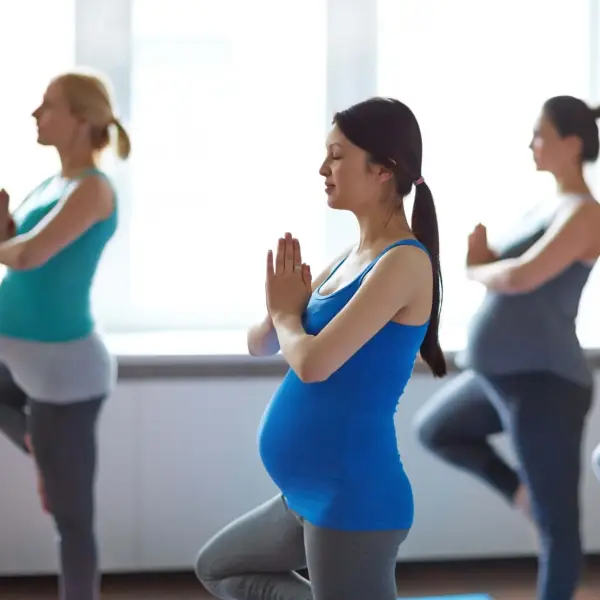Consider Several Factors When Selecting a Yoga Mat for Pregnancy
If you use a PVC yoga mat, then the answer very well may be yes.
The study, published in The Journal of Clinical Endocrinology & Metabolism, found that increases in exposure to certain phthalates during the first trimester of pregnancy was associated with higher estrogen concentrations and lower testosterone concentrations in the fetus, thus increasing the chance of a genital abnormality in male babies at birth.-
The study reinforces the notion that some phthalates are endocrine disrupting chemicals (EDCs) and can alter concentrations of naturally-produced hormones, which help regulate and control different cells and organs in the body. Sathyanarayana’s previous research has directly linked fetal exposure to diethylhexyl phthalate (DEHP) to the development of genital abnormalities and increased risk of future reproductive health issues in boys. Sathyanarayana sat down with On the Pulse to discuss the key findings of the study:
If you use a PVC yoga mat, then the answer very well may be yes. You have options: You Don’t Have to Use a Yoga Mat Loaded With Chemicals
Exposure during early pregnancy to some phthalates—man-made chemicals commonly found in household plastics, food and personal care products—can have adverse impacts on developing fetuses, according to a new study led by Dr. Sheela Sathyanarayana, a pediatric environmental health specialist at Seattle Children’s Research Institute and associate professor at the University of Washington.
The study, published in The Journal of Clinical Endocrinology & Metabolism, found that increases in exposure to certain phthalates during the first trimester of pregnancy was associated with higher estrogen concentrations and lower testosterone concentrations in the fetus, thus increasing the chance of a genital abnormality in male babies at birth.-
The study reinforces the notion that some phthalates are endocrine disrupting chemicals (EDCs) and can alter concentrations of naturally-produced hormones, which help regulate and control different cells and organs in the body. Sathyanarayana’s previous research has directly linked fetal exposure to diethylhexyl phthalate (DEHP) to the development of genital abnormalities and increased risk of future reproductive health issues in boys. Sathyanarayana sat down with On the Pulse to discuss the key findings of the study:
We know many of our readers are – or plan to be – expecting mothers.
As such, we want to ensure you have all the necessary information.
We encourage you to read the full interview with Sathyanarayana here.

Avoid Exposure to Phthalates in Plastic Yoga Mats
We’ve also added a few notes below on how expecting mothers can avoid exposure to phthalates: Firstly, phthalates are used to soften and increase the flexibility of plastic and vinyl products, including yoga mats, medical tubing, food storage containers, flooring, wallpaper, shampoo, lotion makeup and perfume. Food is the most likely source of exposure to the most harmful phthalates. To limit exposure, expecting moms should do the following:
- Buy low-fat dairy products like skim milk and low fat cheeses instead of high-fat dairy products like cream and whole milk.
- Buy fresh or frozen fruits whenever possible. Avoid canned and processed foods.
- Look for items that are labeled phthalate or BPA-free.
- Minimize personal care products, and focus on simple products with clear ingredients.
- Use glass, stainless steel, ceramic or wood to hold and store foods instead of plastics, and do not microwave food in plastic.
- Do not heat a baby’s milk or food in plastics or put hot liquids in plastic products like sippy cups.
- Check plastic symbols and avoid plastics known to contain phthalates including numbers 3 (PVC and vinyl), 6 (polystyrene foam) and 7 (other, can contain BPA).
- Perform frequent handwashing.
- Minimize handling of receipts.
- Take shoes off at home to avoid tracking dust in that may contain phthalates.
- Keep carpets and window sills clean because these are areas that can often collect phthalates.
It Is Important to Choose a Non-toxic, Yoga Mat That Is Made of Natural Fibers
Learn more about your choices when picking an eco-friendly, non-toxic yoga mat here: How to choose an eco-friendly yoga mat.
Lastly, you can also change your yoga mat. At Yogasana, our yoga mats are handmade in India, using cotton, natural dyes, and no electricity. Learn more about the journey our mats take to get to your front door here.






